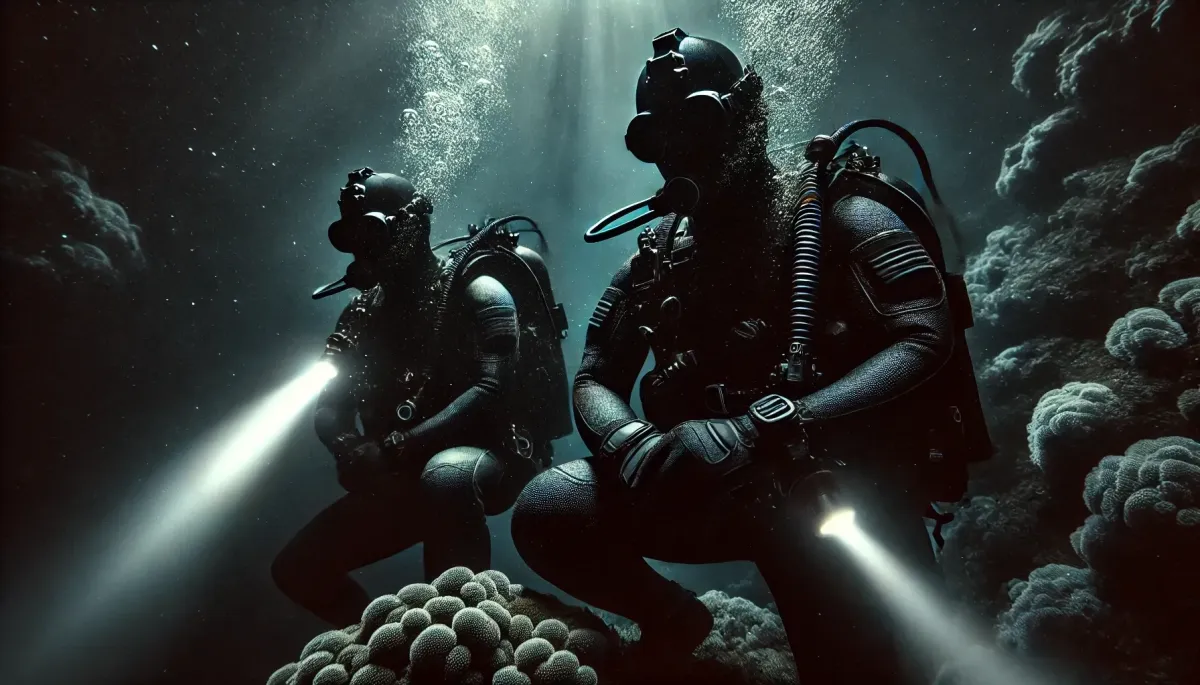
What Success Actually Looks Like
"Everybody wants to be a frogman on a sunny day." Let me unpack this statement for you. I heard this statement many times through BUD/s (Basic Underwater Demolitions, the first 6 months of Navy SEAL training) and throughout my time at SEAL team 3. A frogman is a reference to the SEALs. And Everybody wants to be a SEAL on a sunny day, why? Because when it's sunny you're warm, and when you're warm, you're comfortable. People want it as long as it is easy.
You watch movies and tv shows and think being a SEAL is awesome. What they don't show you are the long cold nights in hell week where you are "jackhammering" (think shivering from being cold, and then think of shivering so hard you look like a jackhammer) so hard your abs cramp up and your jaw is chattering so hard you chip a tooth. You don't feel very cool at stage 3 hypothermia...
One of the absolute coldest and darkest jobs in the SEAL Teams is combat diving. You don't see this one on your tv very often. Guns and Explosions are way cooler than 4 hours underwater in the pitch black.
Let me attempt to describe it to you. Before you even begin the mission, you have to plan your dive. You spend hours staring at maps, ocean charts, and doing the algebra to plan each navigation leg of your dive, accounting for water current direction and every possible variable to ensure the highest chance of success.
Next, you have to "jock up." Don Wetsuit, booties, dive hood, knife, and pistol, then begin sweating profusely. Don the Dreger, 28lbs. (The Dreger is a Closed-circuit diving apparatus. Read: scuba diving with no bubbles on pure O2. And if you accidentally get water inside your mouthpiece, the air becomes poisonous.) All 28 lbs are hanging from your neck. Next, don weight belt and emergency inflation vest, another 8 or so pounds. Finally, don your weapon, and carry in hand goggles and fins.
After you've been inspected to have your gear on and functioning correctly, you are ready to begin your dive. This usually starts with a long silent boat ride in the dark. Once you've reached your insert point, the dive is ready to begin. Whether its pool comp, or a real world dive mission, or just life, entering the water is always dreadful. It doesn't matter if you are wearing a wetsuit the water feels cold no matter what. What makes it even colder is knowing that there will be no warmth for the next 6-7 hours. You just have to let the cold in and be ok with it. It's 11pm, cloudy with hardly any moonlight, and the water is roughly 58 degrees. Hardly what you call a "sunny day."
I enter the water with my dive buddy, and the work begins. We slowly sink as we look each other in the eye and give the signal to descend. We level at about 16 feet underwater. I bring my "attack board" (the attack board is a lightweight plastic or aluminum instrument cluster that has a compass, a watch, and depth gauge on it) up close to my mask to see my compass bearing. I line up the numbers and point us in the right direction. I give my buddy a quick squeeze. He squeezes back, indicating he is ready. We start kicking. I count each left kick, kicking as steady as possible. My kick count is how I determine how far I have swum. Once you go below the surface, you have no idea where you truly are. All you have to go on is your compass and your kick count. Pace and bearing.
After about 20 minutes, we've completed our first leg of the dive. A 900m stretch contouring along the coast of the bay. After I've counted enough kick to indicate the exact distance, I stop, repoint my compass and begin the second leg of the dive, 500m across the bay to a boat ramp. My 275 degree bearing for my second dive leg had me pointed approximately 50m to the right of a concrete boat launch ramp. As we swim across the bay, I swim near the bottom. I had thoroughly studied the ocean charts of this bay before the dive, and I knew where I was attempting to cross the bay it was about 25 feet at its deepest. As planned, my depth gauge reads 23 feet as I hover just above the bottom when I am about half way across the bay according to my kick count. This gives me some small indicator of where I am. As we continue to kick, I see my depth gauge rise and rise as we get closer to the shore of the bay. I keep kicking along the bottom until my depth gauge is at 12 feet. I stop at this point because I don't want to get any closer to the surface. I make a left turn and begin to contour along the bay with the ground rising up on my right side. The plan is that I should swim for 50m or so until I swim across a concrete boat loading ramp. There is only one of these in this part of the bay. Reaching this concrete ramp is what we called a "warm and fuzzy" or a fixed point. It will give me an indicator that I know exactly where I am under water. Fixed points are few and far between. At this time, it's been almost an hour since my eyes slipped below the dark surface. My only sense of location coming from trust in my compass and my kick count.
These small legs of 50m or so where you are searching for a known point are always the scariest. Your fear is that the current takes you too far to the left side of the boat ramp, and no matter how far you swim, you will never run into it. That fear turns the seconds into minutes. The 60 seconds or so it takes to swim that distance feels like 10 minutes. I'm doing my best to swim a proper heading and not move up or down in the water while at the same time focus on detecting the boat ramp when I cross. It's too dark to see. I'll only be able to feel it through my gloves. You don't want to drag your hand along the bottom and kick up a bunch of dirt either. I just poke the ground every few feet as I swim. After about 50M worth of kicks, my heart starts racing.
Did I miss it? Did I swim over it? I start rehearsing the two legs I've already dove. I think back to my dive plan. Did I misremember one of my compass bearings? Am I lost? I keep swimming. Poking the ground. Poking the ground. Poking the ground. YES. That's it. I felt the concrete. I take a deep breath through my dive rig. So deep, I feel myself start to rise in the water, and then I exhale. I refocus. I know where I am, and I think about my next leg of the dive. 150M to a wooden pylon pier.
I'm at the concrete ramp for roughly 30 seconds. I make sure my swim buddy feels it as well, so he knows where we are. A couple quick squeezes, and we kick off again, into the unknown. We continue this process of underwater navigation for 2 more hours, 95% of the time not quite sure of our actual location until finally, we reach our target, an enemy vessel. We wait underwater at the bow of the vessel for the rest of our team to arrive so we can remove our gear and silently climb aboard the ship...
One of my favorite lines from the SEAL Ethos is "Earn your Trident every day." (Trident is the military warfare device that you wear on your uniform signifying that you are a SEAL) And if I could add to that statement: Tridents are earned in darkness.
It's funny how I was never wearing my trident during any of the difficult activities I did to earn it or after I'd earned it, trying to prove worthy of it. On the flip side, whenever I was physically wearing my uniform and trident, I was never doing anything that difficult. The entire time during those dives you feel anything but brave, or cool, or heroic or any other term people may use to describe SEAL actions. Throughout the whole dive, you are cold and miserable, doing all you can to focus and stop wishing you were somewhere else. You are constantly doubting if you are in the right place. The Oxygen from the dive rig builds up over time, and one of the symptoms of O2 buildup is anger and frustration. Really, it feels like rage. The first time your dive buddy tugs on the buddy line keeping you connected you want to pull out your knife and stab him. All the while, you are doing your best to stay calm and stay focused on the mission.
A Few Takeaways:
1. Achievements are made in darkness, success is revealed in the light.
2. On the path to success, you will often be unsure of your current position. Stick to the plan and don't let fear make you second guess into a mistake. Take heed of the warm and fuzzies (fixed points)
3. If you want to accomplish anything significant, you can't be scared of the dark.

